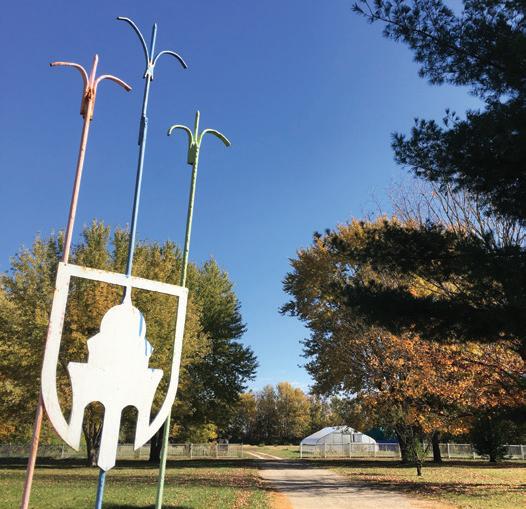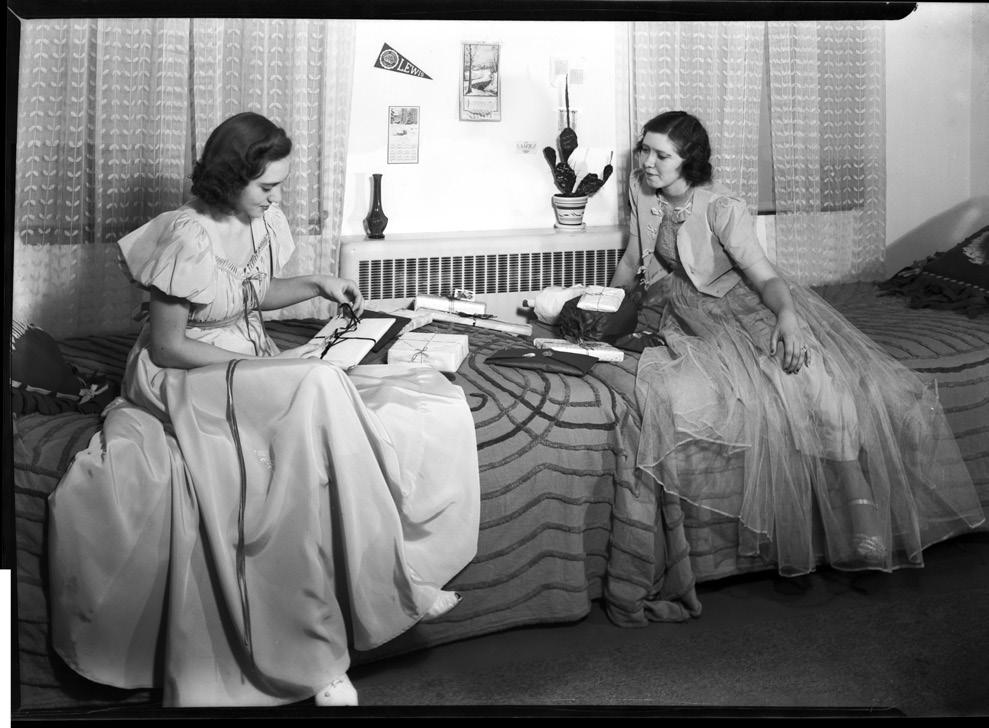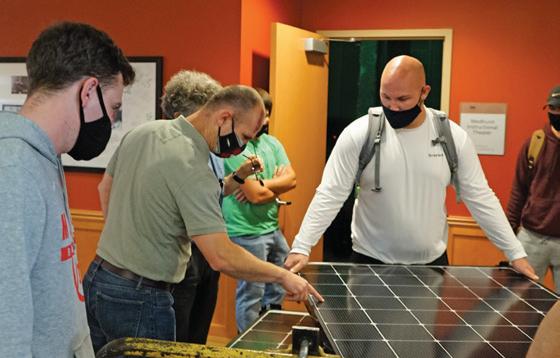
16 minute read
in the scotlight
IN THE SCOTLIGHT
REGINA BANNAN JOHNSON ’01
Advertisement
Her old college research paper inspired fund for diversity at Monmouth
By BARRY McNAMARA
Two decades ago as a monmouth college student, Regina Bannan Johnson ’01 wrote a history paper that shed light on the life and times of Champion Miller, a Black man who was a distinguished member of the Monmouth community in the 19th century.
That paper was part of the inspiration for the College’s founding of the Champion Miller 1860 Fund, which supports campus diversity initiatives such as lectures, student programming, student recruiting and employee training.
“In a million years, I never thought that, 20 years later, my paper would be relevant, or that Champion Miller’s name would come back up,” said Johnson, who is today Monmouth College’s were unable to locate her. Miller’s son died serving the Union in director of multicultural student services. the Civil War.
Johnson recalled pressing longtime history professor Miller was instrumental in the organization of the First William Urban for permission to write about Miller for his historiography class. “I wanted to write about underrepresented students, and I got him intrigued,” she said. “He said no one had really put anything together on that topic for one of his classes.” “We need to be more reflective of who Champion Miller was and African Church of Monmouth, which was founded by Monmouth College President David Wallace in 1865, and which later became Fourth United Presbyterian Church. After that congregation was disbanded in 1871, he attended First United Presbyterian Church, which was organized by the founders of Monmouth College in 1853. Miller died in 1882 at his Monmouth home. He and his wife are buried in Monmouth. Harrod said that creating the Champion Miller 1860 Fund what he accomplished.” Born a slave, Champion Miller came to Monwas part of a broader College initiative to focus on diversity, equity and inclusion.mouth from Kentucky “This resulted in Regina’s research on Champion to be utilized and purchased his freedom in December 1848 for $600 (the to help move our mission forward,” said Harrod. “I am proud equivalent of $19,740 in 2020). that we are telling Champion’s story. Monmouth College has al-
“Regina did amazing historical research that utilized oral ways been a place to educate women, people of color and others tradition as one source,” said Monmouth development officer who some in society believed did not deserve to be educated.” Mollie Williams Harrod ’07. “This is notable because when Johnson is pleased that the subject of her research is being studying history in higher education, written documents are recognized. often the only accepted research avenue, leaving the stories “I think it’s really cool that this fund has been established,” of enslaved people like Champion untold and incomplete. As said Johnson. “We need to be more reflective of who Champion a College, we are lucky that Regina was able to bring to life Miller was and what he accomplished. He was a very polished, Champion’s incredible journey from slavery to freedom.” very bright man, and he was as well respected as a man of color
Miller was taught to read and write by William T. Moffet, a could be in Warren County at that time.” student of the Monmouth Theological Society, which operated Johnson said she’s had no luck in her attempts to trace the gein conjunction with Monmouth College between 1858 and 1874. nealogy of Miller’s two daughters, but hopes to keep searching.
After he established himself in Monmouth, Miller traveled to “It would be really amazing if research could be done on Missouri to purchase freedom for his wife for $800 ($26,300 that and we could track down some of Champion’s relatives,” in 2020 dollars) and one son for $400 ($13,150). His enslaved she said. “I would love for this tale to unfold to more than just daughter was sold just prior to the Civil War, and the Millers having a fund in his name.”
Johnson was surprised but pleased when her historiography research paper from 20 years ago inspired the naming of Monmouth College’s new fund for diversity initiatives.
A Celebration of Scots Day
Monmouth’s beloved spring tradition continues to evolve and mature
By Jeff Rankin Editor ‘In the spring a young man’s fancy lightly turns to thoughts of love,” the poet Tennyson wrote. For generations of Monmouth students, though, the renewal of life on campus following a brutal Midwest winter has turned their fancy to an annual celebration, known in recent years as Scots Day.
Most recently, the day has evolved into a broader observance, encompassing alumni worldwide, who celebrate their alma mater by donating to special projects that benefit Monmouth’s current students.
2021 marks the fifth year of this Scots
Day of Giving. It is especially suited to operating despite a pandemic, through its use of a digital platform that allows alumni to view the giving total each project, as well as participate in challenge gifts and even post their own videos to encourage others to support a cause.
The virtual aspect of Scots Day is also enhanced by events livestreamed on Facebook. It begins with a bagpipe serenade in front of Wallace Hall before sunrise and ends 18 hours and 53 minutes later (in recognition of Monmouth’s founding year), with cowbells and confetti celebrating the completion of another successful campaign.
Throughout the day, Scots far and wide watch live video updates from students, faculty and staff, discussing how that year’s special projects will benefit the campus community.
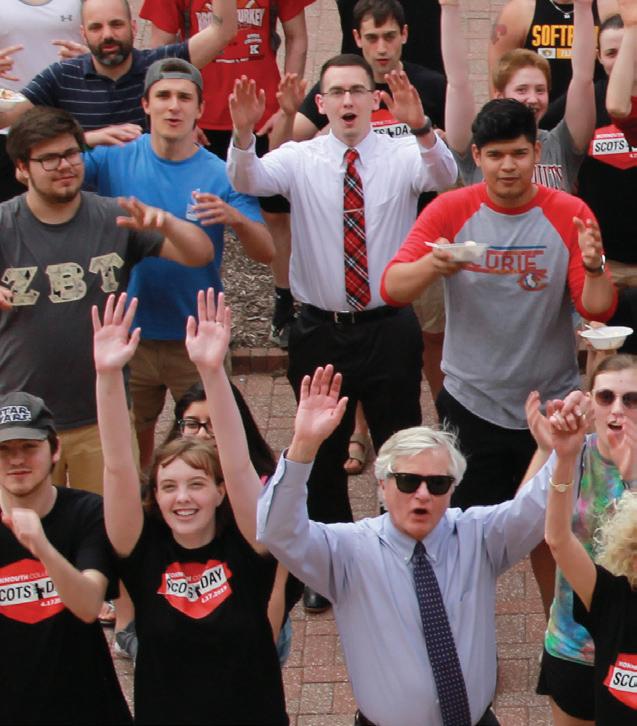
As the work day ends, many alumni congregate for happy-hour gatherings in person, or more recently via Zoom. But there will still be several hours to go, as volunteers return to their phones, calling for more gifts and pledges. Soon, a U.S. map will be converted completely to Monmouth tartan, signifying donors have come forward from each of the 50 states.
Scots Day 2020 lacked the typical festive atmosphere, in which Scots Day Central—a phone bank and video screen on the lower level of the Center for Science and Business—buzzed with activity, with students walking through and purchasing raffle tickets for prizes. That’s because the campus had gone on lockdown almost exactly one month earlier, with students returning home and most faculty and staff working from home. Borrowing from Nevertheless, 725 loyal earlier Scots Day traditions, Scots responded, donating the current $204,000 during the Scots Day of Giving begins nearly 19-hour marathon, before dawn demonstrating that with a lone piper playing virtual technology can be on Wallace Hall remarkably effective—a Plaza. conclusion that would be reinforced over the coming months, as Monmouth figured out how to not only teach but also hold traditional ceremonies and alumni events via the internet. Over the course of just four years, Scots Day of Giving has generated nearly $817,000 in gifts. Among the special projects it has funded are a 3D ceramic printer, a virtual human anatomy simulator, a Chorale trip, the Rural Teachers Initiative, Classics Day and musical (Continued on next page)
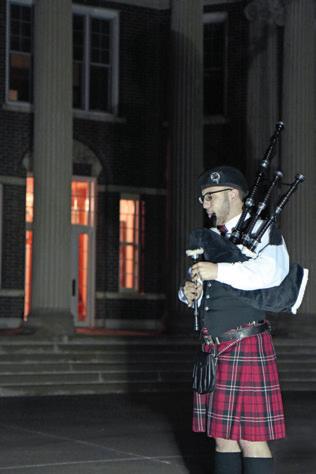
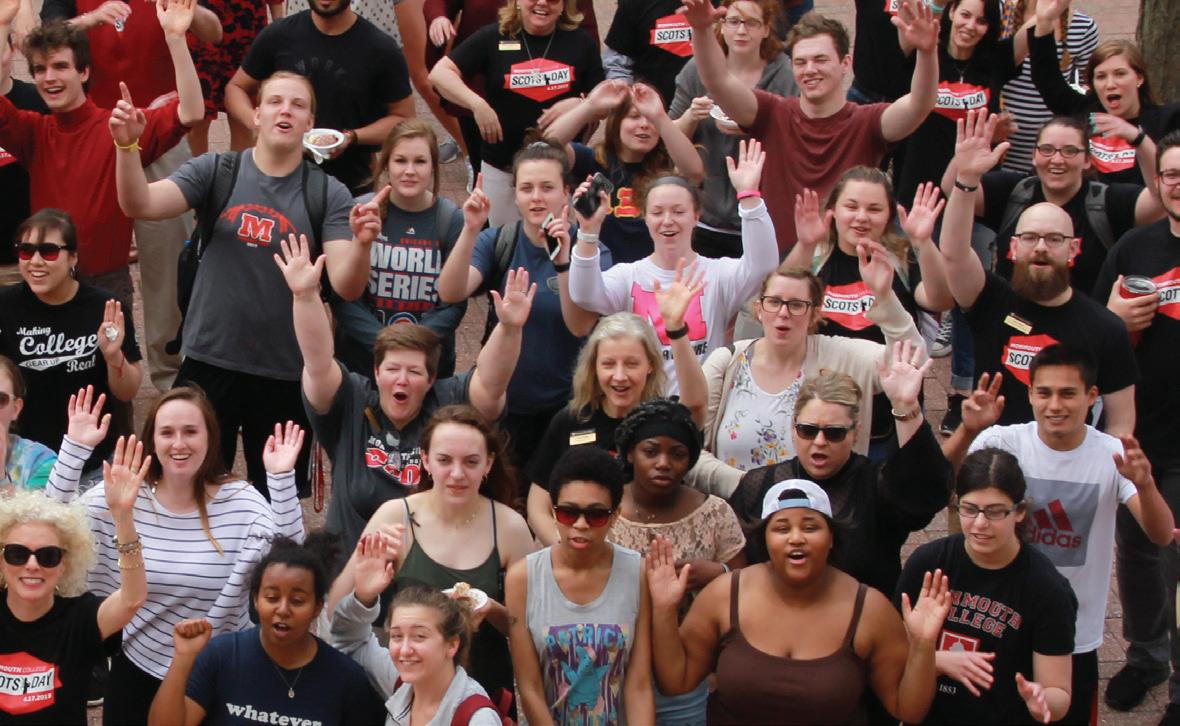
LEFT: Students, faculty and staff gathered on Dunlap Terrace give a Scots cheer during a recent Scots Day of Giving.
First Lady Lobie Stone and President Clarence Wyatt are among dozens of volunteers manning the phone bank on a typical Scots Day of Giving.
An ice cream social draws the campus community together during the afternoon of Scots Day.
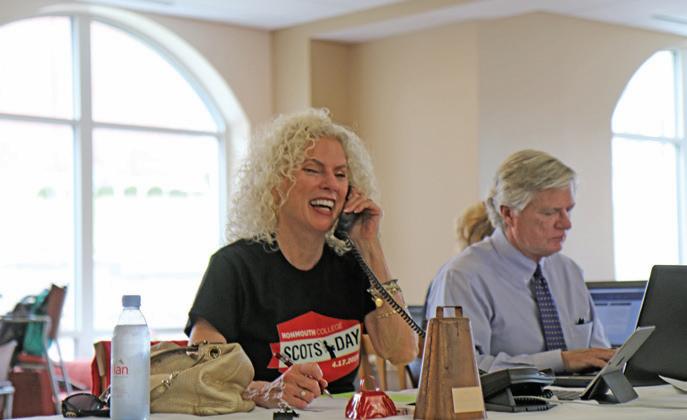
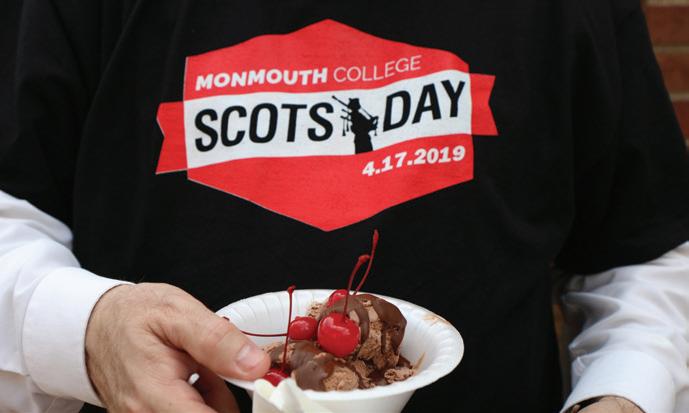
Professor emeritus Lee McGaan ’69 (right) chats with Kyle McEwen ’13 and his wife, Laura, at a local Scots Day happy hour, held in downtown Monmouth. instruments. Each year, funds are also collected for the senior class gift, the Fighting Scots Society (athletics) and the all-important Monmouth Fund, which narrows the gap between the cost of tuition and the actual expense of educating each student.
Although this year’s Scots Day will again be primarily virtual, there will be a feeling of anticipation, as in-person classes and labs (with social distancing) and the resumption of intercollegiate sports are heralding a return to normalcy.
But as we look forward to the end of this winter and the promise of future vibrant springs that remind us of the old days on campus, let’s take a moment to look back to those former times of glory and how they evolved into the current Scots Day.
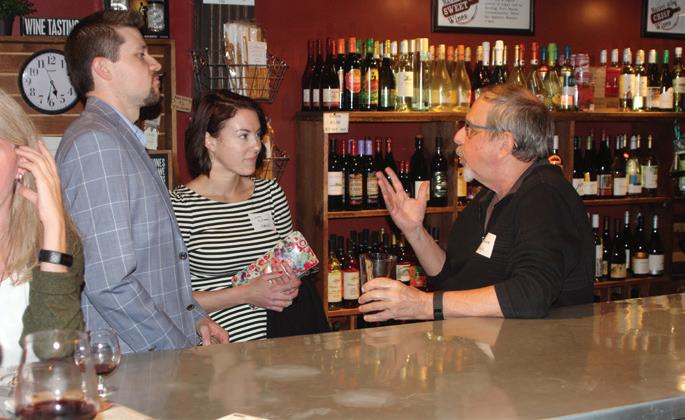
Many younger alumni remember Scots Day as a time for celebrating spring with classes cancelled, outdoor games and general partying (which often began the night before). To avoid confusion, that day still exists under a different name and with a different focus. Now titled Scholars Day, the event still begins with a morning Honors Convocation, but the rest of the day is devoted to celebrating academics—with a luncheon for scholarship recipients and donors, poster sessions, arts presentations and fun outdoor activities, weather permitting.
Some older alumni remember a much older spring tradition, known as the May Fete. Ralph Whiteman ’52, who grew up in Monmouth, witnessed the spectacle many times, and would be among the last to experience it as a student before it ended in 1957.
“As a youngster in the Monmouth College neighborhood, one of the things
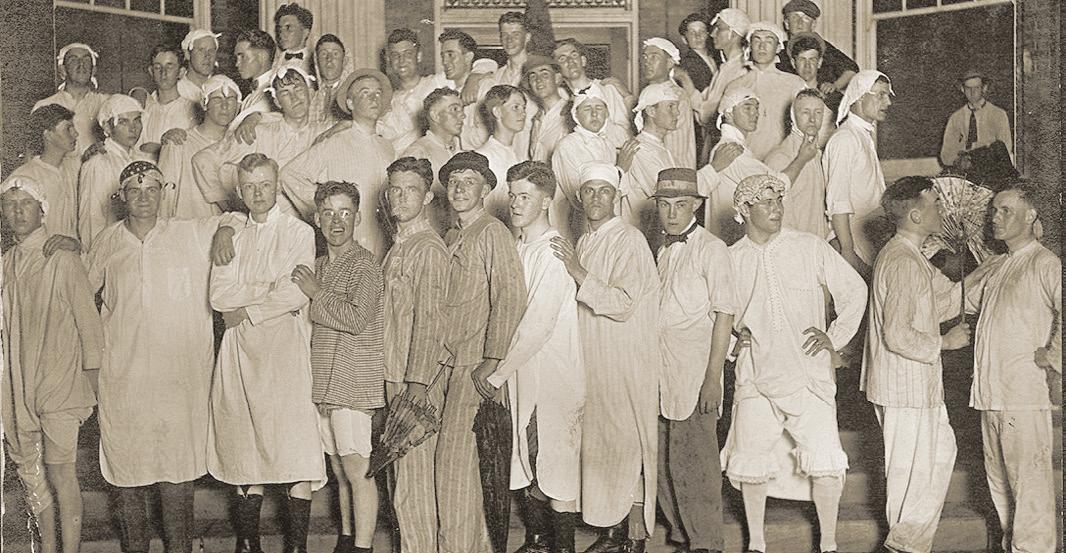
we looked forward to was the May Fete,” he said. “It was very colorful and involved a lot of student musicians and dancers. The pole and streamers were set in aptly named Valley Beautiful, where the elected king and queen presided over the program.”
The Monmouth College May Day tradition began in 1896, when Monmouth’s two female literary societies—Aletheorian and Amateur des Belles Lettres—staged a pageant in the Auditorium that included the crowning of a queen and a Maypole dance. The event rapidly grew in popularity, causing it to be moved outside to the Valley Beautiful, a former creek bed behind Wallace Hall, which is today occupied by a parking lot.
While the May Party was initially performed exclusively by women and children of the community, the College men were not completely left out. An annual male tradition held the night before the event was the Nightshirt Parade or “Nighty Night,” which began with a mock Maypole dance. According to a local newspaper, “Gowned in ‘night shirts’ of various hues (the men) gave the usual mock ceremonies on the campus and then headed by a little traveling German band, made a weird march down through the heart of the city. Refreshments were secured and then the various members of the faculty were visited.”
The morning of the May Party, the male students and male faculty also got to cast their votes for the Queen of the May. Then the ceremonies would begin, with College women dressed in elaborate costumes, parading to the grounds, which featured a platform and throne for the queen. The costumed ladies would then perform elaborate dances, ending with the winding of a Maypole.
As the event evolved, it took on the name May Fete, and added a Chancellor, who was elected to escort the Queen. Beginning in 1958, the King and Queen of the May reigned instead over a spring formal, which would continue for decades as a popular annual event.
(Continued on next page)
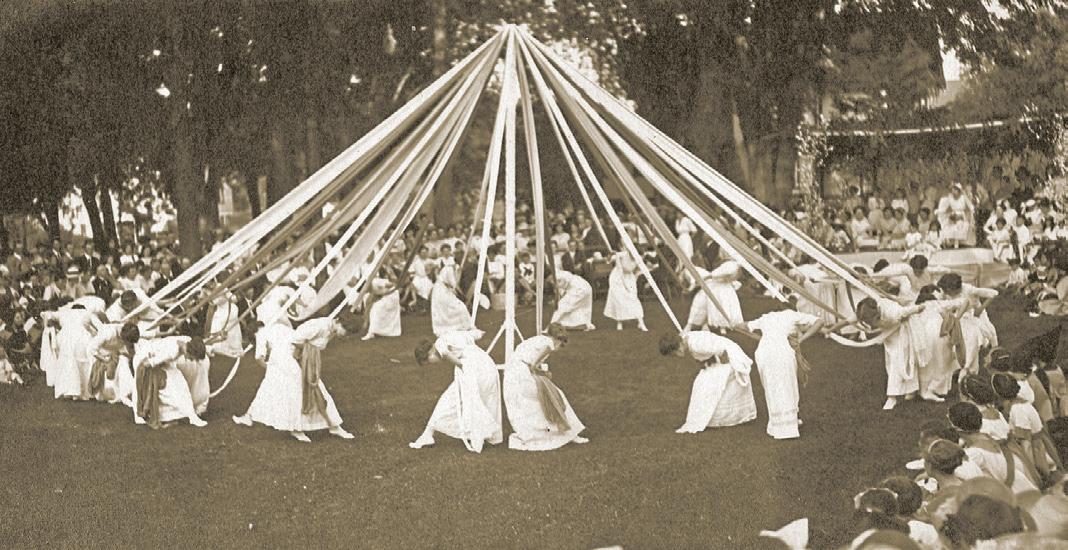
Eagerly anticipated by hundreds of town-and-gown observers, the May Party, later known as the May Fete, concluded with an elaborate and colorful winding of the Maypole. It was initially staged in the Valley Beautiful, a former creek bed now occupied by a parking lot at the base fo the Wallace Hall hill.
After the May Fete went out of style, students tried to initiate “Skip Day,” in which they took a holiday from classes, but faculty resistance shot it down. In 1962, Blue Key held its first Scots Sing, a springtime musical competition that remains popular to this day under the name “Scotlight.”
In 1963, Whiteman, who had become the first director of the new Student Center, created the ScotOlympics, which debuted on the athletic field following the MonmouthKnox track meet. In what was billed as a “brain versus brawn” contest, College staff defeated a faculty team in relay races around the track. In addition to bicycles, contestants rode a hobby horse, a live pony, a pogo stick, skiis, a baby carriage and a tricycle. Subsequent student races ended in numerous bloody spills.
The 1964 ScotOlympics would be reported by The Associated Press, as it was preceded by a stunt mimicking the famous six-day French track bicycling event, but added on an extra hour— logging a total of 1,450 miles. Student women would keep a bike going from 7 a.m. until 7 p.m., when men would take over. All went fine until the weight of a football player caused a bike wheel to collapse. Publicity director John Niblock ’58 also got in on the fun, planning to ride his bike behind a large blanket, then emerge on the other side riding a
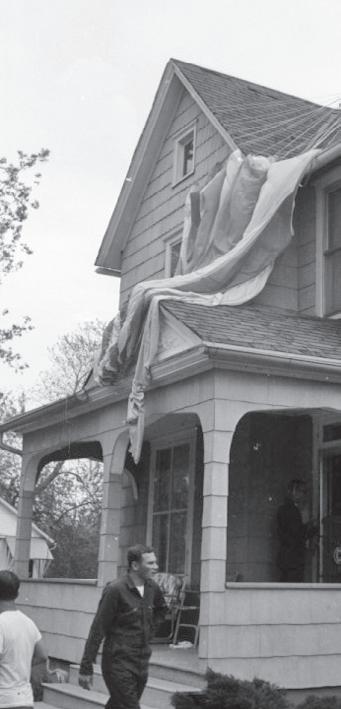
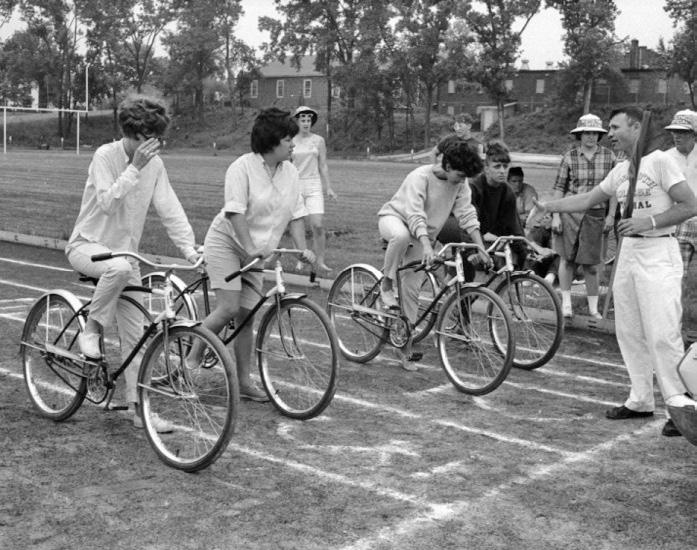
Student activities director Ralph Whiteman ’52 gives last-minute instructions to ScotOlympics bike race participants during the 1965 ScotOlympics.
motor bike. According to Whiteman, “He entered too fast on his bike and came in sliding on his side. His handlebars became antlers and the Elks initiated him on the spot!”
To gather a crowd for the 1965 ScotOlympics, Whiteman planned a skydiving exhibition, in which two skydivers would land on the field. “They tossed out their windsock to check velocity and it landed right on the 50yard line,” Whiteman recalled. “They jumped OK until about 200 feet high, when the wind carried them parallel to the ground west about two blocks, where one diver landed on the roof of the proprietor of a student bar and the other landed in the mayor’s garden.”
Typical ScotOlympics events included a water ballet in Waid Pool, pie eating, a raw egg toss, a wheelbarrow relay and bike races. Independent students were very enthusiastic, because for the first time they were included with Greeks in the social programs.
The 1966 edition honored beloved English professor Eva Cleland, but also took on a pop-culture element, paying tribute to that year’s wildly successful Batman television show. Each fraternity submitted a candidate to be named Vampira, Queen of the Bats. The nominees’ photos were forwarded to Batman star Adam West, who selected Sandra Wade ’67 to reign over that year’s festivities.
As the “flower power” movement blossomed, so did a popular springtime phenomenon on college campuses known as the Festival of Life. Monmouth’s first such festival took place on May 1, 1971. The all-night affair, featuring folk and rock performances, was to run from 7 p.m. until 7 a.m. on the Wallace Hall Plaza, but fear of police intervention eventually drove the affair into the gym. The ScotOlympics of that year were an equally ambitious undertaking, featuring evening concerts by REO Speedwagon and the Ides of March.
Combining the back-to-nature appeal of the Festival of Life with the zaniness of ScotOlympics, students in 1974 celebrated a “Festival Olympics” with outdoor movies and concerts on the Hewes Library terrace. Participants brought sleeping bags and spent the night in the quad (then known as People’s Park). The same year was also notorious for its Streakers Weekend, when Ray Stevens serenaded the nation with his novelty song and Monmouth students shed their clothes, running a gauntlet between Gibson Hall and Winbigler Hall.
The 1980s saw the emergence of Scots Day as an integral part of the school year. The date of the event was kept a closely guarded secret, only revealed to the College community when a bagpiper would stroll through residence halls at 7 a.m., blasting students out of bed. Teams would then gather for breakfast on Wallace Hall Plaza in their pajamas, and a day of games, from tug-of-war to Jell-O wrestling, would ensue.
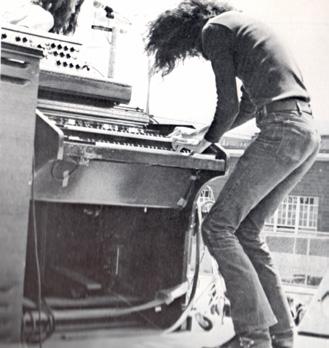
(Continued on next page)
Mad John entertains at Monmouth’s 1973 Spring Festival in People’s Park.
By 1993, the value of Scots Day was being questioned. Faculty did not like the idea of students dictating when classes would be canceled, and the administration worried that the “secret” date for the celebration was leaking out, leading to student drinking binges the night before. The following year, the event was replaced with “Scots Weekend” so that class attendance would not be compromised.
President Sue Huseman took office in 1995 under the theme “Creating Community.” She believed that instilling a campus-wide sense of pride in the College’s heritage would help bring students and faculty together. Scots Weekend was scrapped and Scots Day was reinstated as a planned event featuring Honors Convocation, Scottish
food in the dining hall, a trip to South Henderson Church (where the College had its roots), music and games. In 2000, Monmouth’s Scottish heritage was further incorporated into the celebration with the introduction of the “Flatland Games,” adding competition in the caber toss, hammer throw and tug o’war. For a couple of years, the name was changed to Ceilidh (pronounced Kay-Lee), the name for a traditional Scottish folk festival, but it was eventually abandoned because of the confusing spelling and pronunciation.
During the decade that followed, outdoor inflatable games were added to the outdoor spectacle, but weather didn’t always cooperate, so in 2012 the games were moved into Huff Athletic Center’s Glennie Gymnasium. At the same time, the rest of the athletic center was used to celebrate academics, with poster sessions, theatrical and musical performances and demonstrations. The Hatch Distinguished Scholarship and Research faculty award was also presented.
The opening of the Center for Science and Business in 2013 brought a new excitement to academics, and the spacious building seemed custom-made for celebrating Scots Day, which had been redubbed Scholars Day. By 2018, the poster sessions had expanded to such an extent that they were moved to the more spacious Huff Athletic Center fieldhouse.
Planning for an annual day of giving based around Founders Day (April 18) began in 2016. By this time, the name Scots Day had been retired, but it was so ingrained in the fond memories of alumni that the planning committee decided that no other name would do, so the new Scots Day debuted to great fanfare in the spring of 2017.
There is no doubt that support generated from alumni and friends during Scots Day of Giving will continue to play a major role for years to come in the College’s academic programs, as well as in the lives of students, just as Scots Day will continue to evolve to serve the needs of the next generation of Monmouth students.
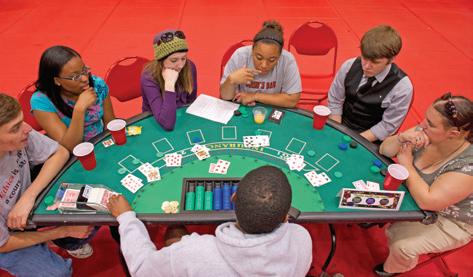
As the rest of the Huff Athletic Center hosted academic events in 2012, students also enjoyed a casinothemed Scots Day in Glennie Gymnasium. Scots Day took on an even more Scottish flavor in the early 2000s, with the introduction of Scottish games.
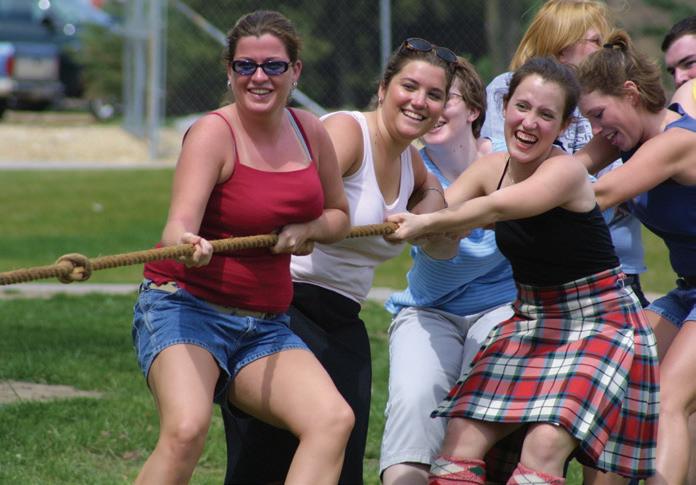
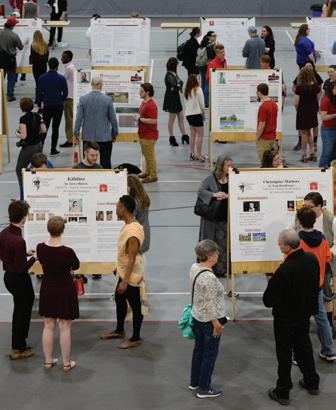
An academic poster session drew an appreciative crowd to the Huff Athletic Center fieldhouse during 2019 Scholars Day.



